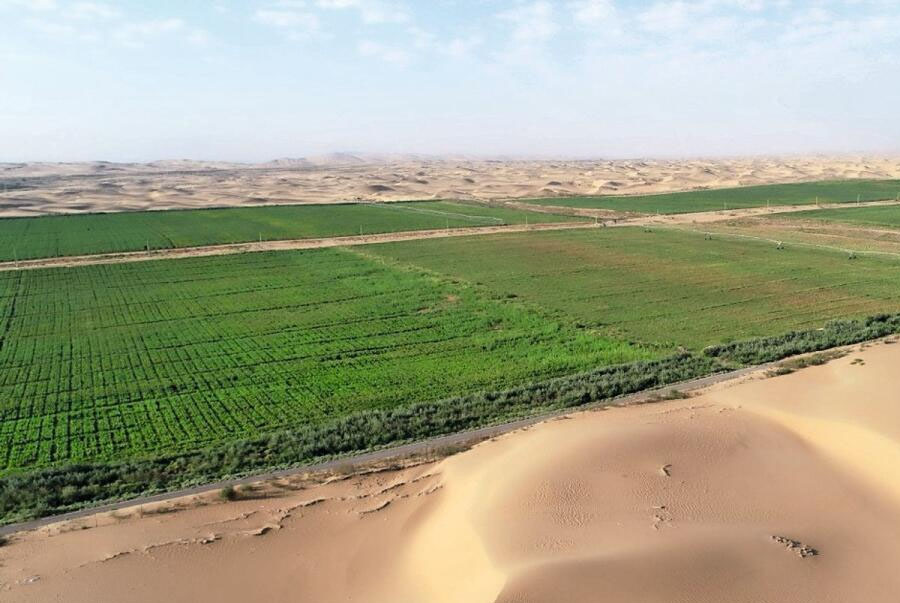Hi readers! If I ask you Is Saudi Arabia an agricultural country?
You will probably laugh aloud as Kingdom of Saudi Arabia with:
Diverse, barren and harsh climate,
Soil with salt flats, gravel plains and sand deserts,
Few man-made lakes,
No permanent stream except Rub Al-Khali (Empty Quarter),
Arable land of 3.43 million hectares in 2020 (1.6% of total land),
The largest sand desert in the world,
June to August temperature of over 110 degrees Fahrenheit during mid-day in the desert, and
Rainfall, from none at all to 20 inches a year in the mountains:
the circumstances under which
no one can think of having any kind of agricultural activity as it is waste of time, money and manpower resources.
But it would be unbelievable for many and shocking for the world to know that today, Saudi Arabia exports wheat, dates, dairy products, eggs, fish, poultry, fruits, vegetables and flowers to the markets around the world. Dates: once a staple of the Saudi diet, are now mainly grown for global humanitarian aid.
The miracle happened due to fresh brain, vision and policies of the Crown Prince of KSA, and the efforts of Ministry of Agriculture whose developmental work specifically to provide water for agriculture produced wonders. For example.,
A network of dams has been built to trap and utilize seasonal floods,
Vast underground water reservoirs have been tapped through deep wells, and
Desalination plants have been built to produce fresh water from the sea for urban and industrial use, thereby freeing other water sources for agriculture,
Facilities provided to treat urban and industrial runoff for agricultural irrigation.
These efforts collectively helped transformed vast tracts of the desert into fertile farmland that helped 400,000 acres in 1976 to reach nearly 52.7 million ha in 2020 of which nearly 3.43 million ha is being cultivated which is an astonishing accomplishment.
(https://tradingeconomics.com/saudi-arabia/arable-land-hectares-wb data.html#:~:text=Arable%20land%20(hectares)%20in%20Saudi,compiled%20from%20officially%20recognized%20sources.)
Help from subsidies and interest-free loans; grain silos and flourmills organization which purchases and stores wheat, construct flourmills, and produces animal feed., land distribution and reclamation programs and funds from the government for research projects., technical support services, free seeds and fertilizers, low-cost water, fuel and electricity, duty-free import of raw materials, machinery., private sector participation through government provided long term interest-free loans, and help from Saudi Arabian Agricultural Bank (SAAB): all facilitated this development.
All this is in common with what we have and practice in Pakistan, but
the questions is that with so many commonality between Pakistan and Saudi Arabia (that converted desert into farmland) why Pakistan could not produce wonders in Agriculture?
We know that:
Pakistan is amongst the world’s top ten producers of wheat, cotton, sugarcane, mango, dates and kinnow oranges, and is ranked 10th in the world in rice production.
Rice is the major food staple and one of the country’s important cash crops. Other crops include sugarcane, chickpeas, pearl millet (bajra), corn (maize), rapeseed and mustard, and several garden crops such as onions, peppers and potatoes?
Pakistan currently placed at 5th position in global cotton production after India, China, USA and Brazil?
Please don’t forget that:
Pakistan is basically an agricultural country with:
Three big dams (Mangla, Tarbela, Neelum Jhelum), two under constriction dams (Diamer Bhasha, and Mohmand dams) and few small dams (Naulong Dam, Kurram Tangi Dam, Nai Gaj Dam, and Dawarat Dam) in the initial stages of development,
Possess one of the world largest network of irrigation canals and allied distributary channels,
Arable land of nearly 24 million hectare exclusive of 6.30 Mha of saline land,
Irrigation water of 69-98 Million Acre Feet (MAF) and
Over 40% of rural population engaged in agriculture,
Despite all this, it will be astonishing for many that for the last 4-5 years Pakistan instead of exporting has been importing wheat, cotton, cane sugar and even vegetables of daily consumption.
Why?
Why is agriculture low in Pakistan? Your will find the answer during the course of this narrative
The management of crop production in Pakistan possess many challenges such as,
Absence of on farms soil testing laboratory (what AARI is doing)?
Unavailability as well as poor quality of fertilizers (what Fauji Fertilizer is doing)?
Poor quality seeds (what seed certification departments are doing)?
Loses during and after harvesting and deteriorating soil fertility (what huge extension departments are doing)?
Lack of warehouses, machinery, and equipment (what Ministries of Agriculture in various provinces are doing despite having huge budget)?
The most important cash crop (cotton) has declined from 14 million bales in 1992 to just 4.9 million bales in 2022-23: the lowest around four decades and a year-on-year decline of 34% which ruined our textile industry,
The area under the notorious Bt., cotton is currently 7.4 million acres which includes seeds with questionable Bt., expression levels that played pivotal role in cotton destruction in Pakistan: a country known for its inherently best quality of cotton (over 90% of which fall in Grade III or base grade) or even better.
It is said that production has declined due to:
Climate change,
Less genetic diversity,
Stresses caused by whitefly infestation and
Cotton leaf curl virus disease (something that we heard in 1990 and since then it is one the rise),
Frequent pink bollworm attacks that is part and parcel of imported Bt., cotton, and
Un-standardized procedure of variety approval that is largely based on parochialism.
Do you know dear readers! That
Pakistan is famous for its Kinnow production, which is also an export commodity, but
Israel is one of the world’s leading fresh citrus producers and exporters, including oranges, grapefruit, tangerines and a hybrid of a grapefruit and a pomelo, developed in Israel. More than forty types of fruit are grown in Israel: a country with total arable land of 652,000 ha of which only 230,000 ha (35 % of the arable land) is cultivable, and saltwater of the Mediterranean Sea as primary source of water for the country. But over the years, Israel has become water superpower by implementing,
Centralized water planning and real pricing,
Appointing regulators,
Educating citizens to conserve water,
Desalination of sea water,
Drip irrigation utilization and
Treatment of nearly all of its sewage and recycling it for crops.
Pakistan produces world’s best Basmati Rice: the major food staple and country’s important cash crops,
Nevertheless, our dearest friend China is leading worldwide production of rice, and wheat, second largest producer of corn, and the largest producer of vegetables including onions and cabbage. The answer to the above-mentioned questions is therefore,
the most uncommon traits found in Saudi Arabia that differentiate KSA from Pakistan are Honesty, Dedication, Commitment and Conviction that forced KSA to believe that a desert can be converted into cultivable farms which made it happen. Pakistani do not believe themselves, talking of the country notwithstanding. Pakistani believes in short cuts, optics, deceit, and lies: the qualities that does not allow a huge crowd of uncouth people to prosper. Saudi Arabia do not possess these qualities that is why she is shocking the world with their development and developmental plans.
Dear readers! we know fully well that Food drives the world, which means, unless we produce, stockpile and distribute food stuff to those who cannot afford, the world cannot sustain., hence access to adequate food is primary concern for most of the people on earth which makes agriculture one of the largest and most significant industries in the world. Its productivity is important for a country’s balance of trade (terribly affected in Pakistan) which means difference between the monetary value of a nation’s exports and imports over certain time period.
With that in mind, countries producing and exporting most of the agricultural products around the world are trying to increase their production levels (what are we doing)?
United States, China, India, and Russia are top producers of major cereals and vegetable crops,
Africa and Asia (with India and Nigeria) are the leading producers of Millet: a major crop in Africa. Likewise, barley, rye, and beans are produced in USA but are crucial crops in Russia, Germany, and India.
China and India (both top agricultural producers) have large populations and internal food security hence, maximum portion of their produce is consumed internally.
What about our food security? Have we mortgage it? I guess so, but I may be wrong?
Mahatma Gandhi once said “There is enough on this planet for everyone’s need but not for everyone’s greed”
What do you think?
See you next week,
Bye





